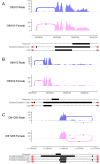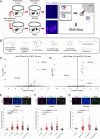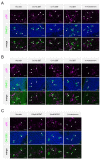Semiochemical responsive olfactory sensory neurons are sexually dimorphic and plastic
- PMID: 33231170
- PMCID: PMC7732343
- DOI: 10.7554/eLife.54501
Semiochemical responsive olfactory sensory neurons are sexually dimorphic and plastic
Abstract
Understanding how genes and experience work in concert to generate phenotypic variability will provide a better understanding of individuality. Here, we considered this in the main olfactory epithelium, a chemosensory structure with over a thousand distinct cell types in mice. We identified a subpopulation of olfactory sensory neurons, defined by receptor expression, whose abundances were sexually dimorphic. This subpopulation of olfactory sensory neurons was over-represented in sex-separated mice and robustly responsive to sex-specific semiochemicals. Sex-combined housing led to an attenuation of the dimorphic representations. Single-cell sequencing analysis revealed an axis of activity-dependent gene expression amongst a subset of the dimorphic OSN populations. Finally, the pro-apoptotic gene Baxwas necessary to generate the dimorphic representations. Altogether, our results suggest a role of experience and activity in influencing homeostatic mechanisms to generate a robust sexually dimorphic phenotype in the main olfactory epithelium.
Keywords: mouse; neuroscience; olfaction; olfactory receptor; pheromone; plasticity; semiochemical; sex differences.
© 2020, Vihani et al.
Conflict of interest statement
AV, XH, SG, SK, EB No competing interests declared, HM HM receives royalties from Chemcom.
Figures





















References
-
- Abrunhosa I, Gulea M, Levillain J, Masson S. Synthesis of new chiral thiazoline-containing ligands. Tetrahedron: Asymmetry. 2001;12:2851–2859. doi: 10.1016/S0957-4166(01)00481-5. - DOI
-
- Brann DH, Tsukahara T, Weinreb C, Lipovsek M, Van den Berge K, Gong B, Chance R, Macaulay IC, Chou HJ, Fletcher RB, Das D, Street K, de Bezieux HR, Choi YG, Risso D, Dudoit S, Purdom E, Mill J, Hachem RA, Matsunami H, Logan DW, Goldstein BJ, Grubb MS, Ngai J, Datta SR. Non-neuronal expression of SARS-CoV-2 entry genes in the olfactory system suggests mechanisms underlying COVID-19-associated anosmia. Science Advances. 2020;6:eabc5801. doi: 10.1126/sciadv.abc5801. - DOI - PMC - PubMed
Publication types
MeSH terms
Substances
Associated data
- Actions
- Actions
- Actions
Grants and funding
LinkOut - more resources
Full Text Sources
Molecular Biology Databases

